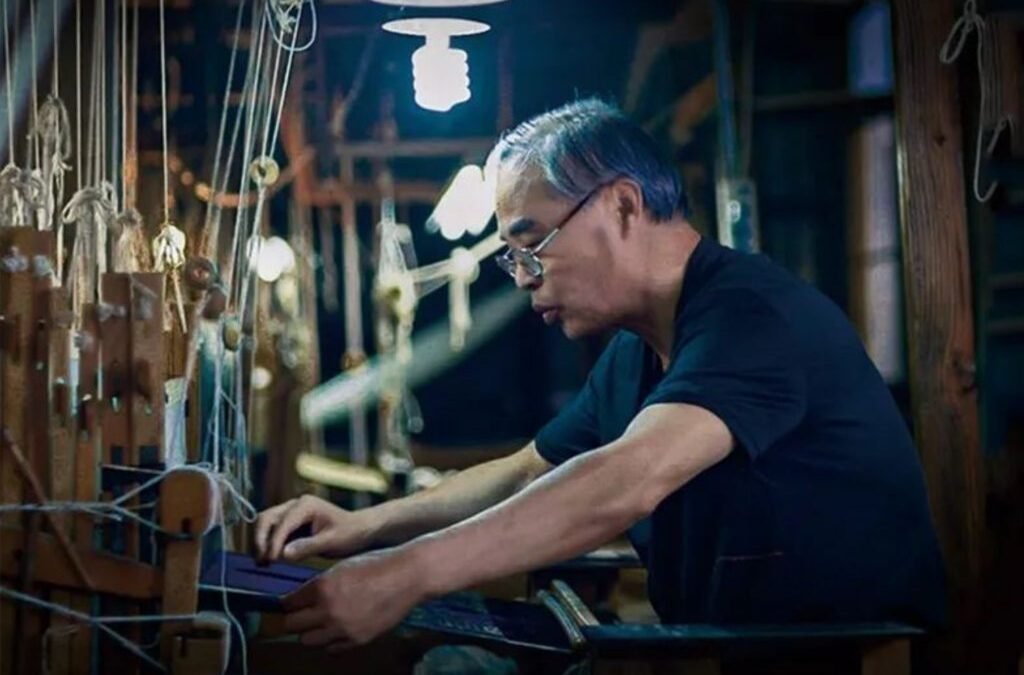Li Hailong and the Forbidden City: Reviving China’s Silk Legacy
Li Hailong and the Forbidden City: Reviving China’s Silk Legacy
I. Millennium Restoration of Lacquer-Gauze Windows
In the 2010s, Li Hailong’s team was commissioned by the Palace Museum to restore the **Qianlong Garden’s Fuwangge Lacquer-Gauze Windows**, a project under UNESCO’s conservation initiative for endangered cultural heritage. These Qing Dynasty architectural marvels, crafted with **four-thread twisted leno (si-jing jiaoluo)** as the base and adorned with lacquer and gold leaf, required reviving the lost composite technique of “twisted-silk gauze + lacquer art.”
By microscopically analyzing fragments from the Palace Museum’s archives, Li discovered that the gauze base achieved a warp density of **86 threads/cm**, mirroring Han Dynasty silk unearthed at Mawangdui. After three years of painstaking effort, his team replicated the gauze base on traditional wooden looms and collaborated with lacquer masters to restore the gold-leaf detailing. The restored windows now exhibit an ethereal “mist-like translucency with golden veiling,” bridging a 300-year technical gap and proving the multifunctional role of **Wu Luo** in historic architecture.
II. Rebirth of Imperial Attire
For the Forbidden City’s *”Palace Weddings: Dragon-Phoenix Auspiciousness“* cultural project, Li’s team recreated the Qing Empress’s **Vermillion Embroidered Dragon Robe (Zhu Hong Zhuang Hua Luo Yun Long Wen Ji Fu)**. Woven on a **four-thread twisted leno** base using the *”five-color inlay“* technique, this masterpiece consumed **7,635 hours** and **300,000 meters of thread**, reviving the luxurious texture of *”inch-for-inch gold“* brocade. The robe was later enshrined in the *Classic Qing Court Attire* collection, serving as a vital reference for studying imperial textile craftsmanship.
Additionally, Li reproduced **Han-Tang Dynasty costumes** depicted in Dunhuang murals, including the half-sleeve Tang brocade for the *”Painted Silk-Clad Wooden Figurine“* from the Tang Dynasty. Using plant-based dyes, he restored ancient hues, reawakening Silk Road artifacts that had slumbered for millennia.
III. Technological Archaeology and Academic Breakthroughs
Li’s collaboration extended beyond restoration. In 2020, he co-founded the **Experimental Archaeology Research Center for Ancient Silk Fabrics** with the Chinese Academy of Social Sciences, leveraging the Forbidden City’s collections to decode historical weaving techniques. By comparing Song Dynasty *kesi* (tapestry) and Ming Dynasty brocade, he proposed the **”Wu Luo Gene Chain“** theory, tracing the evolution of twisted-silk techniques from four-thread to twelve-thread structures.
With the Palace Museum’s support, Li adapted **four-thread chain leno** for modern haute couture, such as the empress costumes in *Story of Yanxi Palace*. By integrating electric looms, he boosted production efficiency by **180×** while preserving the fabric’s porous elegance, democratizing royal luxury.
IV. Cross-Disciplinary Innovation
The Forbidden City’s openness enabled **Wu Luo** to transcend tradition. Inspired by Fuwangge’s windows, Li developed translucent, heat-insulating **architectural curtain walls** using leno’s honeycomb structure. He also prototyped a **”bulletproof leno vest“** with the Palace’s文创 team, harnessing the fabric’s shock-absorbing potential—though not yet commercialized, it showcased traditional craftsmanship’s scientific relevance.
These endeavors transformed **Wu Luo** from a museum relic into a **living cultural legacy**, embodying Li’s philosophy: *”Preserving heritage isn’t about replicating history, but applying ancestral wisdom to modern challenges.“*
—
**Keywords **: Li Hailong, Forbidden City, Wu Luo, four-thread twisted leno, si-jing jiaoluo, Qianlong Garden, lacquer-gauze windows, cultural heritage preservation, imperial textile restoration, experimental archaeology,非遗 (intangible cultural heritage), sustainable innovation.
Contextual Citations:
: Restoration of Fuwangge lacquer-gauze windows and technical specifications.
: Han-Tang costume replication and plant-based dye techniques.
: Academic research on silk evolution and modernization of weaving technology.
: Imperial robe recreation and cultural project collaborations.
: Cross-disciplinary applications and philosophical insights.


